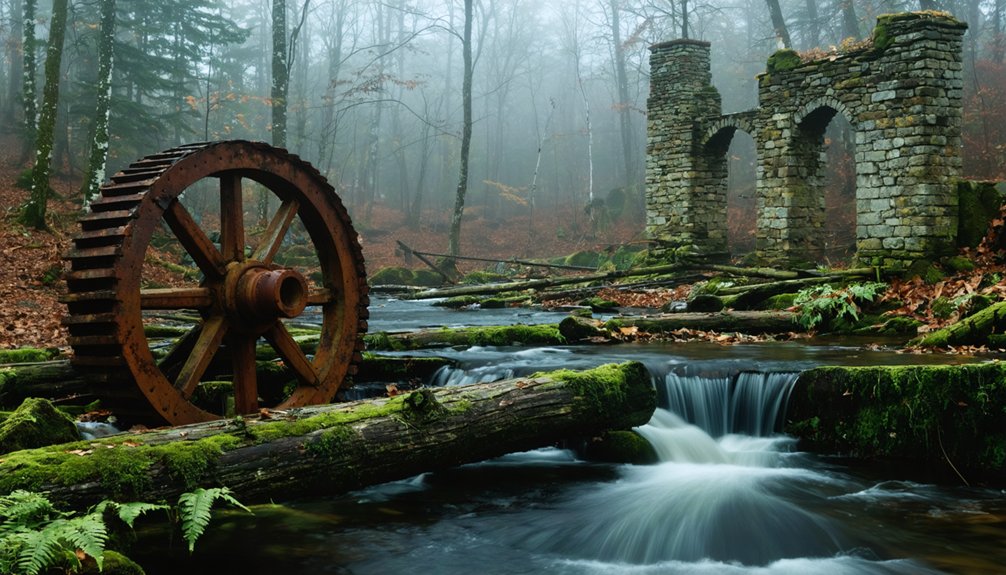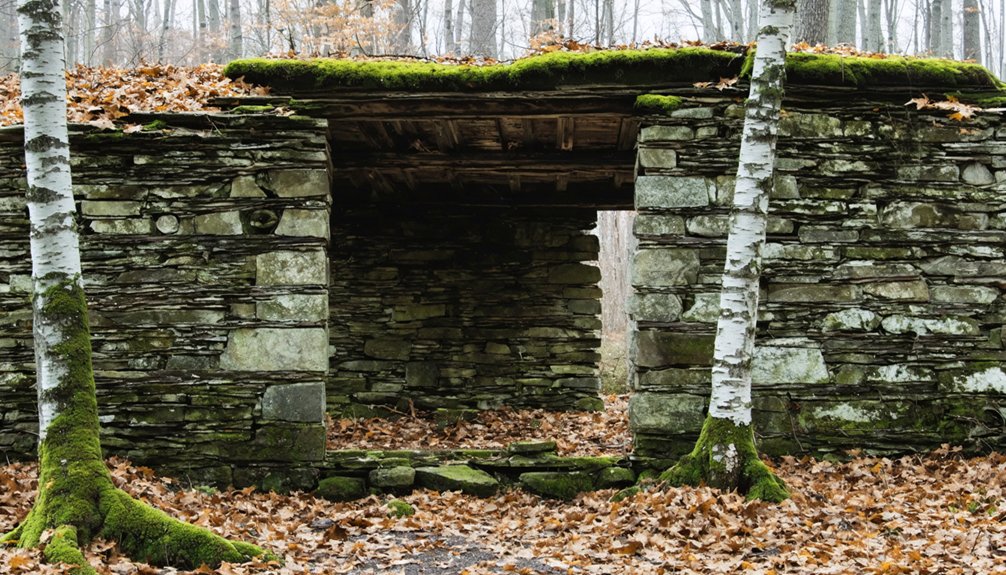You’ll find the abandoned mill village of Beebe River tucked away in Campton, New Hampshire. In 1917, Parker Young Company built this model community with modern amenities, including 18 houses with electricity and indoor plumbing. The village thrived as the world’s largest bobbin producer under Draper Mills Corporation, employing 230 workers and processing timber from 22,000 acres. Today, the empty homes and silent mill buildings tell a fascinating story of industrial innovation and decline.
Key Takeaways
- Beebe River transformed from a thriving industrial village to a ghost town following economic decline in the late 1920s.
- The village once contained 18 modern houses, a boarding house, general store, school, and playground before abandonment.
- Draper Mills Corporation’s reduced bobbin production and timber depletion led to the community’s eventual desertion.
- Railroad operations ceased as the workforce declined, marking the end of the village’s industrial transportation network.
- The abandoned settlement represents the decline of New Hampshire’s early 20th-century lumber and textile manufacturing industries.
The Rise of a Model Mill Village
When the Parker Young Company envisioned a new lumber operation in 1917, they didn’t just plan a mill – they designed an entire model village along the Beebe River in Campton, New Hampshire.
Under Martin Brown’s utopian design, eighteen modern houses sprung up, complete with luxuries you’d rarely find in rural communities: electricity, running water, and indoor bathrooms.
A visionary model of rural modernization, where basic amenities became luxurious symbols of progress in a worker’s paradise.
You’d have found everything needed for a thriving community here. A boarding house welcomed 200 guests and workers, while the general store served multiple purposes as a post office, town office, dance hall, and movie theater.
The community planning showcased progressive ideals with a school, railroad station, pond, ballfield, and playground – all carefully arranged to create an ideal living environment for mill workers and their families.
The village’s success continued when Draper Mills Corporation took over in 1924, transforming the lumber operation into the world’s largest producer of bobbins.
The mill’s early operations focused heavily on producing spruce for airplanes during World War I, contributing significantly to the war effort.
Industrial Legacy and Bobbin Production
The Woodstock Lumber Company‘s ambitious village wouldn’t remain solely focused on lumber for long. In 1924, Draper Mills Corporation acquired the operation, transforming it through industrial evolution into the world’s largest bobbin producer.
Under Draper’s ownership, bobbin technology revolutionized the site’s purpose, shifting from raw lumber to specialized textile manufacturing components. The mill’s location along Spencer Brook tributary provided essential water power for operations.
You’ll find these remarkable production achievements at Beebe River’s peak:
- 100,000 wooden bobbins manufactured daily
- 230 workers employed during maximum output
- 22,000 acres of forest feeding the operation
- Vertically integrated system connecting forest to finished product
The mill’s transformation showcased New Hampshire’s adaptability, as Beebe River became a vital gear in America’s textile industry.
Draper’s innovative approach turned this remote village into a global leader in bobbin manufacturing, supporting automatic looms across the nation.
Railroad Network and Logging Operations
Built following a 1917 legislative charter, the Beebe River Railroad stretched 25 miles from Campton’s Boston & Maine connection deep into New Hampshire’s White Mountains, ending near Mount Whiteface in Waterville.
As cutting-edge logging technology for its time, the railroad transformed timber harvesting in the region. You’ll find evidence of twelve logging camps that once dotted the line, with hidden mountain camps scattered across steeper terrain. The Boston and Maine Railroad provided essential rail service connections through its Pemigewasset Valley Branch.
The railroad’s economic impact extended beyond local logging – its spruce timber even contributed to WWI airplane manufacturing. The Woodstock Lumber Company operated this complex network of mainlines and spurs, efficiently moving timber from virgin forest stands to their sawmill at the confluence of the Pemigewasset and Beebe Rivers, where a bustling mill village once stood. The Parker-Young Company played a crucial role in overseeing these extensive logging operations.
Daily Life in Beebe River’s Golden Age
Life in Beebe River flourished during the village’s heyday as a model company town designed by Woodstock Lumber Company in 1917.
You’d find a remarkable emphasis on worker welfare, with homes featuring modern amenities rare for rural logging communities: electricity, running water, and indoor bathrooms.
The vibrant social fabric centered around community gatherings at these key locations:
- The general store, which hosted movies, dances, and served as the post office
- A boarding house accommodating up to 200 workers and guests
- The village school, where workers’ children received their education
- Recreation areas including a playground, ballfield, and pond
Daily life balanced work at the world’s largest bobbin mill with rich social connections, creating a close-knit community where families thrived despite the demands of industrial labor. Like many ghost towns of New Hampshire, Beebe River’s once-bustling streets now stand silent. The land companies eventually purchased these properties primarily for timber harvesting, leaving the buildings to decay over time.
From Thriving Community to Abandoned Settlement
Despite its remarkable success as a model company town, Beebe River’s industrial prosperity began unraveling in the late 1920s when multiple economic forces converged.
You would’ve witnessed dramatic community dynamics shift as timber resources depleted and demand for wooden bobbins declined with changing textile technologies. The town’s economic changes proved devastating – its specialized focus on lumber and bobbin production left little room for adaptation.
Without diversified industry to sustain it, you’d have seen the once-bustling railroad cease operations, while the workforce of 230 people steadily dwindled.
The remote location that once served the logging operation well now hastened its isolation. One by one, families departed the modern homes and community amenities that had made Beebe River a model of industrial innovation just years before.
Frequently Asked Questions
Are There Any Original Buildings From Beebe River Still Standing Today?
You’ll find ruins and remains of mill buildings along Route 175, but there’s no clear historic preservation evidence or documentation confirming any fully intact, original structures with architectural significance still standing today.
Can Visitors Legally Explore the Abandoned Beebe River Village Site?
No, you can’t legally explore the village site. Current exploration guidelines and visitor permissions restrict access since it’s on protected conservation land. Trespassing could result in prosecution and safety risks.
What Happened to the Families Who Lived in Beebe River?
You’ll find those hard-working families scattered to the winds when economic decline hit – they packed up and migrated to other New England towns and cities where lumber and textile jobs still flourished.
Are There Ghost Stories or Legends Associated With Beebe River?
You won’t find documented ghostly apparitions or established local folklore specifically tied to Beebe River, though nearby Star Island has tales of the Beebe children’s spirits playing near their graves.
How Much of the Original Railroad Infrastructure Remains Visible?
You’ll find significant railroad remnants along the old railbed, including bridge abutments, logging camp artifacts, and converted trails. While steel rails were removed in 1942, the historical significance remains clearly visible today.
References
- https://www.laconiadailysun.com/community/outdoors/following-the-beebe-river/article_5ddcc012-92a7-11e9-a3b2-5bee7698d29f.html
- https://www.scenicnh.com/blog/2018/04/beebe-river-railroad/
- https://uphsnh.org/the-beebe-river-mill
- https://en.wikipedia.org/wiki/List_of_ghost_towns_in_New_Hampshire
- https://www.whitemountainhistory.org/abandoned-towns
- https://www.holyokecanaltour.org/beebe-holbrook-paper-mill/
- https://www.nhpr.org/arts-culture/2019-08-06/the-once-and-future-mill-camptons-dole-mill-from-1826-to-1965
- https://tile.loc.gov/storage-services/master/pnp/habshaer/nh/nh0100/nh0195/data/nh0195data.pdf
- https://en.wikipedia.org/wiki/Beebe_River
- https://www.scenicnh.com/blog/tag/beebe-river-railroad/



